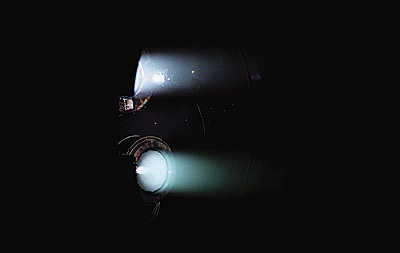
HAYABUSA cruising smoothly
Directing its course toward earth, the asteroid explorer “HAYABUSA”
is cruising with its three purple lights shining in the raven black space. Feeling
unsatisfied with just looking at the numbers passing over the screens at ground
control station, I have an urge to fly to HAYABUSA in order to check the ion engine’s
grid holes and touch the engine to check the temperature of the parts with no
temperature sensors attached.
On May 9, 2003, the M-V-5 rocket carrying the MUSES-C explorer roared into the
blue sky and disappeared. When its radio signal was received at Kagoshima station
after the earth had rotated beneath it, the explorer was given the new name “HAYABUSA.”
It marked the moment that _-10, a microwave-discharge-type ion engine developed
over 15 years, finally became “space-borne.” From end May 2003, we carefully
ignited the engines’ plasma one by one to begin ion acceleration. To our
unexpected delight, we were able to confirm in real time the velocity change of
HAYABUSA’s ion engine acceleration by measuring the Doppler shift of communication
signal wave. From July, when the engine tests and adjustments were completed,
it began cruising operation, continuous acceleration for 24 hours without real-time
monitoring from the earth. By end February 2004, the four ion engines had attained
10,000 hours in accumulated operation though the engines did not operate during
year-end and new-year holidays.
HAYABUSA successfully entered a trajectory that will bring it nearby the earth
in early May 2004. When flying nearby the earth, its accumulated velocity vector
by ion-engine acceleration will be diverted in the direction of the target celestial
body, the asteroid Itokawa. HAYABUSA will be accelerated continuously after that
and is expected to arrive at Itokawa around the fall of 2005.
 |
| Fig.1 Simultaneous actuation of two microwave-discharge-type
ion engines (terrestrial test) |
| Top: Development model |
 |
Bottom: Prototype model |
|
|
![]()

![]()
